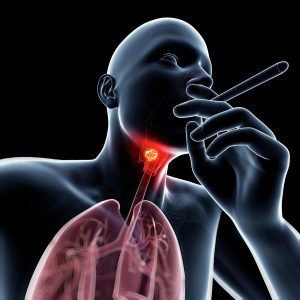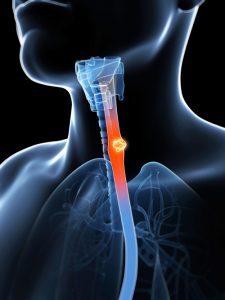Laryngeal cancer is a malignant tumor made from epithelial cells that line the walls of the larynx. The main, but not the only risk factor leading to the formation of a malignant neoplasm is smoking. Dust, high temperature, high content of combustion products of tobacco, oil products in the inhaled air, admixture of soot and phenolic resins, alcohol consumption are also common “provocateurs” of the development of laryngeal cancer. Tumor formation usually occurs against the background of long-term chronic processes. You should pay attention to such diseases as:
leukoplakia and leukokeratosis,
pachyderma,
benign tumors – papillomas and fibromas,
scars and cysts of the larynx, as a result of traumatic injuries and acute diseases,
chronic inflammatory processes in the larynx, accompanied by smoking and alcoholism.
There are no specific symptoms characteristic of early stage laryngeal cancer. They usually resemble a cold or are absent altogether. What are the symptoms you shouldn’t ignore?
1. Hoarseness of the voice, which patients often associate with smoking
2. Barking, excruciating cough
3. Purulent, and sometimes bloody sputum
4. Putrid breath
5. Discomfort in the throat when swallowing, which eventually becomes permanent
6. Constant pain in the ear and throat
7. Impaired swallowing
8. Intoxication syndrome that occurs in the late stages with the disintegration of tumor cells. It usually manifests itself as general weakness, headaches, insomnia, and rapid weight loss.
Such manifestations should lead any person to a doctor. After all, treatment will be more effective when laryngeal cancer is detected at an early stage.
Laryngeal cancer treatments
The optimal tactics for laryngeal cancer should be selected for each patient individually, taking into account the state of the body, the size and location of the tumor. The most effective combination of several therapies is to target cancer cells in different directions. The following treatments are used to treat laryngeal cancer:
Chemotherapy based on the use of drugs that destroy tumor cells. It is usually used in combination with surgery. Chemotherapy drugs can reduce the volume of the tumor before surgery, as well as minimize the risk of recurrence after surgery. The only and weighty drawback is that the drugs do not have a specific effect and, together with tumor cells, infect healthy cells.
radiation therapy is a method of damaging a tumor with a beam of directed ionizing radiation. Cancer cells are more sensitive to radiation than healthy cells. However, as with chemotherapy, healthy cells die.
Both methods have a common group of side effects associated with damage to healthy tissue:
nausea and vomiting
diarrhea
weight loss
destruction of hair follicles and hair loss
damage to the leukocyte blood line and, as a result, a decrease in immunity
surgical treatment – complete removal of the larynx, or the affected area. The volume of surgical treatment depends on the size of the tumor, the degree of its invasion into healthy tissues and the immediate localization
The most commonly used combination of surgical treatment with chemotherapy or radiation therapy.
photodynamic therapy is a new treatment method based on the use of photosensitizers (drugs that are sensitive to light) and therapeutic laser radiation with a wavelength that promotes the absorption of the photosensitizer. Such drugs are selective for the affected tissues. Therefore, when exposed to a light source, only pathologically altered tissues are destroyed, and healthy ones remain intact.
Today, photodynamic therapy is one of the most effective methods of treating laryngeal cancer, since it combines a powerful antitumor effect and a clear direction of action.
Thanks to new therapies, the treatment of a diagnosis such as laryngeal cancer https://en.wikipedia.org/wiki/Laryngeal_cancer has become more effective, even in the advanced stages. However, the prognosis of treatment is most successful when contacting a specialist when the slightest symptoms appear.
